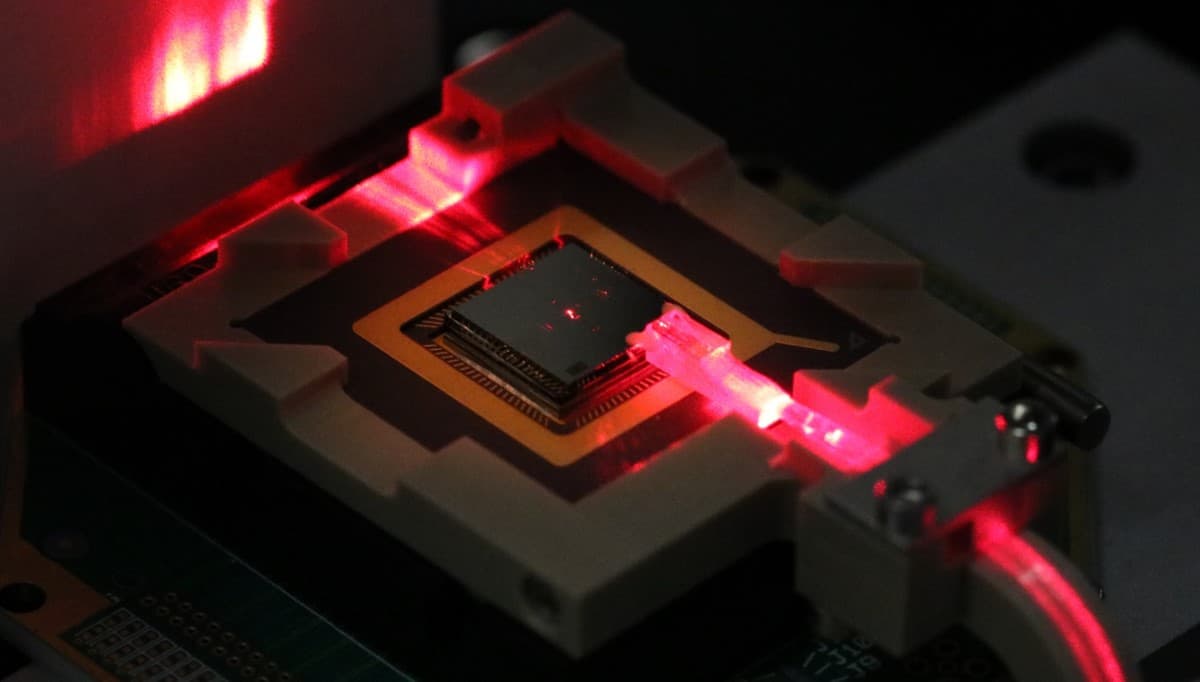Trapped ions share a wired connection
21 Feb 2022 Oliver Stockdale

Scientists at the University of California, Berkeley have persuaded two trapped ions to interact over a distance of 620 µm – much larger than would be possible via their intrinsic interaction – by connecting them with a room-temperature wire. This proof-of-principle experiment provides a pathway to more precise measurements of fundamental physics based on long-distance interactions between trapped particles.
Trapped-ion technologies are an incredibly useful tool in physics. They are a leading candidate to build the quantum bits, or qubits, that make up quantum computers because ions are relatively easy to isolate and high-fidelity gate operations can be performed by the relatively simple means of shining laser light on the ions. Trapped ions are also used to make ultra-precise measurements of fundamental physics, for example in a recently-developed trapped-ion sensor that might prove useful for detecting dark matter.
At the heart of these technologies lies how ions interact with one another. While such interactions can, in principle, take place over infinite distances, the length scale of relevant interactions is much shorter. This creates some barriers to fully harnessing the potential of trapped ions for quantum computing. For example, scaling up quantum computers to large numbers of qubits may require these qubits to communicate with each other over extended distances.
Communicating via a wire
The idea of coupling two ions with an external conductor was first proposed in 1990 by physicists Daniel Heinzen and David Wineland. In their theoretical paper, Heinzen and Wineland outlined how the motion of one ion would interact with an external conductor, which in turn would interact with the other ion. More specifically, as the ions oscillate in their traps at opposite ends of the conductor, they induce image charges – fictitious charges that nevertheless act in real ways – in the conductor. The charges induced by one ion then interact with the second ion as they move through the conductor (and vice versa).
Some 15 years later, Hartmut Häffner, who leads the Ion Trap Group at Berkeley, picked up the idea. “I was intrigued by the question of whether one can transmit quantum information through a normal conducting wire,” Häffner tells Physics World. “Some people said it would not be possible, others said why not? Needless to say, I fell into the latter category.”
A further 15 years on, the idea came to fruition. In the Berkeley group’s experiment, two calcium ions are trapped at either end of an electrically floating wire within different oscillating fields. The vertical motion of each ion is controlled by adjusting the frequency of the oscillation. To show that the two ions interact via the wire, the team looked for evidence of sympathetic heating– a process where one system heats another via their interactions. Sympathetic cooling, an analogous process that cools a coupled system, is generally of greater experimental interest and was demonstrated in a similar context in 2021, when laser-cooled beryllium ions sympathetically cooled protons via a superconducting circuit. Due to strong noise sources within the Berkeley system, however, such cooling was not possible.
Members of the Berkeley team prepared the two ions at different temperatures. While they kept the oscillation of the hotter ion fixed, they varied the frequency of the colder ion. When the frequencies become equal – known as resonance – the colder ion heats up very quickly due to the coupling mediated by the wire.READ MORE

Häffner says it should be possible to use this technique to cool and detect nearly every trappable charged particle given the right experimental conditions. “The coupling we demonstrated is a mechanism which allows one to control arbitrary ions (or elementary particles) independent of their electronic structure with laser light,” he notes. This is particularly important for precision measurements, especially for particles that cannot be laser cooled (such as protons and electrons). The method could thus allow researchers to probe and make more precise measurements of particles’ mass, charge, or internal energy structure, among other things.
Noisy wire limits potential
In addition to demonstrating the concept, Häffner and co-authors describe some possible improvements. If other scientists want to use this scheme to, for example, perform sympathetic cooling or demonstrate transfer of quantum information, they will need to reduce the system’s noise. “It will be very difficult to get into the regime where we can entangle two ions using the wire and show quantum state transfer,” explains Häffner. “Having said that: in principle it should be possible, but just very difficult.”
With a well-developed wire coupling, Häffner and colleagues suggest the scheme could enable several revolutionary ideas. For instance, controlling electrons using this scheme should be particularly favourable, bringing a quantum computer using trapped electrons instead of ions within reach.
The research is described in Physical Review Letters.

Oliver Stockdale is a PhD student contributor to Physics World. Oliver studies quantum physics at the Kirchhoff-Institut für Physik, Universität Heidelberg. Find out more about our student contributor networks.
from physicsworld.com 24/2/2022
Δεν υπάρχουν σχόλια:
Δημοσίευση σχολίου